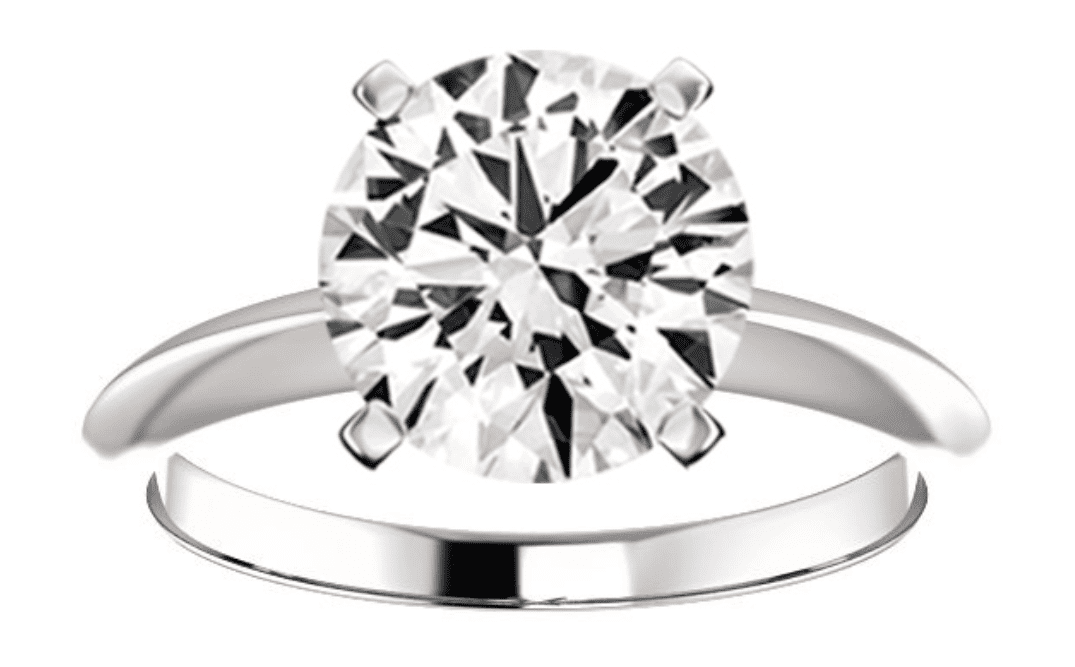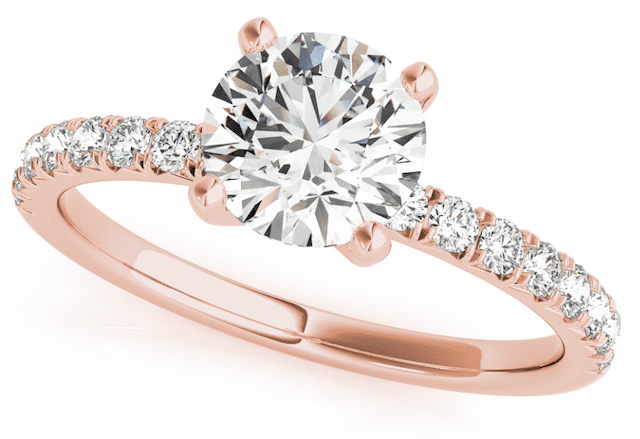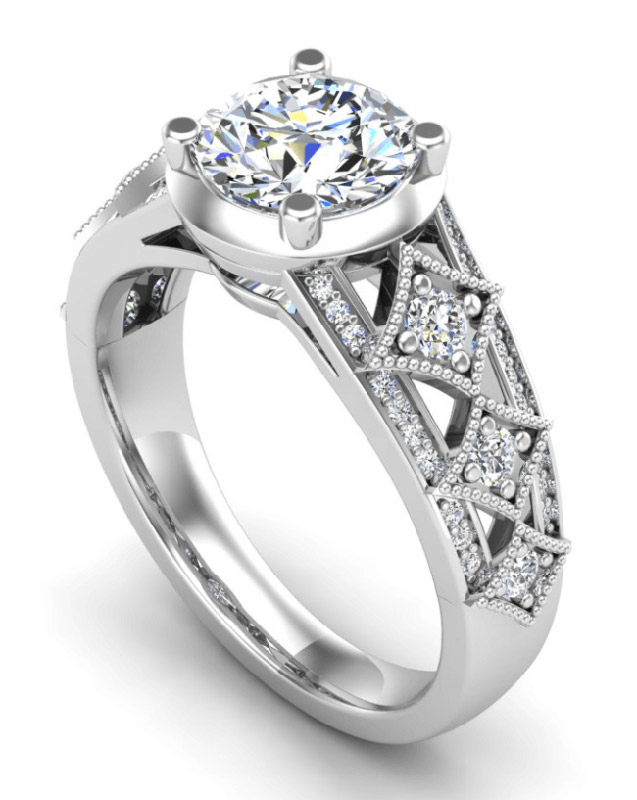Round Diamond Rings: Styles and Ideas | Rare Carat
Our beloved diamonds can be found in almost any shape, size, or color… but the round diamond is easily the top shape sold year after year! This round silhouette is a timeless classic that will never take a dip on the popularity charts (no matter how trendy other shapes might be). With the overwhelming love of these circular diamonds in mind, today’s info session is all about the exciting round diamond ring styles and ideas! So! Let’s get those design options going and creativity flowing!
Design Options
The design options for a round diamond ring are almost endless (check out the bottomless rabbit hole of Pinterest if you don’t believe me…). For manageable purposes, I have broken the categories of design down to the basics: diamond setting, band style, and metal options. Think of each of these elements as a great opportunity to add a little extra flair or some personal touches to your ring!
Diamond Ring Settings
This is a very important step in designing any ring! The setting influences how the diamond is “set” into the band, the way the ring looks, and the overall style that the ring gives off. There are many, many options here, ranging from - the prong, to the halo, to multi stone designs (and beyond).
- Prong: The prong setting is the most common setting and is a total classic. This design is extremely simple, where the base of the diamond sits in a small metal claw with 4 to 6 little metal prongs reaching up and over the diamond, holding the stone firmly in place. The big benefit of having the majority of the diamond still exposed is that light can fully interact with the gem - giving us more sparkle than what other settings allow for. Plus, the prong can be used for a solitaire round diamond, or for multiple or fancy shaped diamonds as well!
- Bezel: Similar to above, the bezel setting can be used for many diamond shapes and types and quantities. However, the aesthetics of it are quite different. Instead of having the sides of the diamond exposed, the bezel requires that the diamond sit fully into the metal with only the top of the stone visible. As you can imagine, this prevents the diamond from reaching its full sparkle potential… but, because most of the stone is covered with metal, it actually makes the bezel the most protective setting we have.
- Halo: The halo setting for a round diamond ring is what we are all familiar with when it comes to the standard halo - the center stone is surrounded by a dazzling circle of smaller round diamonds. The halo (and even the double halo) were super popular for a while, but interest eventually tapered off. Today, I think the halo is on the comeback but in more creative ways! For example, halos that have small fancy shaped diamonds instead of the small circular ones, halos that create a floral vibe, or even incorporating colored gemstone into the halo (like blue sapphires) are just a few ideas that come to mind.
- Three Stone: The three stone setting is just that - a setting for 3 stones. These can definitely be 3 round diamonds, but really any combination of shapes of diamonds that you might want would totally work. P.S. the prong, the bezel, and the halo settings can all be used as a detail within the 3 stone ring setting.
- Tension: In a tension setting, a diamond is held perfectly in place by tension - which is created by the compression of the metal band. This setting is cool because the diamond appears to float in place effortlessly. The free-floating gem design means that light can fully access the stone! …giving us all the sparkles possible.

- Cathedral: The cathedral setting is similar to the prong, but elevated (literally). Metal arches are used to frame the center diamond, resembling arches of elegant European cathedrals. Protective, graceful, and popular - the cathedral is always a solid option.
Band Style
Let me preface this by saying I think technically some of these might still be considered settings, but since they are focused on the band design (as opposed to holding the main stone(s)) I have moved them into this section. Bands might sound slightly less exciting, but they are fundamental in bringing the whole round diamond ring look together!
- Channel Set: Channel set diamonds are usually used to hype up the band of a ring. Small round diamonds are set in a line between two strips of metal, creating a “channel” of diamonds on both sides of the center stone. Those extra diamonds give us all the blingy vibes!
- Pavé Set: Similar to the channel set band, a pavé band gives us extra sparkle! However, the diamonds used here are much smaller and held in place by tiny prongs. This creates more of a “paved” road look (think sparkly cobblestones) - unlike the singular channel of diamonds between two strips of metal.
- Split Shank: The split shank certainly creates interest when it comes to round diamond rings. Instead of having a solid metal band, the band splits in two as it nears the diamond - surrounding that center stone but leaving open space on each side. Feel free to up the bling ante by opting for that pavé detail (with tiny diamonds encrusting the entire band).
- Thick Band: We are starting to see thick and chunky jewelry trending… which is something that can totally be incorporated into a round diamond ring. Having a wider band will create a sturdy base with a more modern or contemporary aesthetic feel.
- Thin Band: Thin bands have been in for a while. They are great for a simplistic design appeal that really allows the diamond itself to be the true showstopper that it is.
Metal Options
One of the first things someone notices about the ring, besides the amazing diamond of course, will be what color the metal around the diamond is. There are a few other pros and cons of each popular metal type, but obviously - color choices are huge when it comes to style and design! These are our top contenders:

Yellow Gold: Yellow gold is most definitely currently in vogue, but it is also always a classic choice. Gold comes in a few purity options, with 18k and 14k being the most popular for jewelry (24K is pure gold for reference). The higher the purity, the softer the metal and the deeper and more golden the color is. For lighter colored golds, go with a lesser purity!
Platinum: Platinum is one of the most popular white metals on the market. It has more of a slight silvery hue than white gold has and is a very strong metal because of its density (but it can still bend out of shape if you aren't careful). It is also one of the most expensive metal options - but it is a really solid choice that will last forever!
White Gold: Speaking of white gold, it is the second most popular white metal chosen for jewelry. A freshly shined piece of white gold will be bright, white, crisp, and clean.
Rose Gold: If anyone is looking for some color, rose gold is the metal for you! The soft pink hue of this metal is romantic and feminine and whimsical. It would be a fun option for people who like to be a little different.
There is a reason round diamonds rings are SO popular - they are timeless, classic, and exactly what we imagine the perfect diamond to be! With all of the settings, the bands, and the metal options we have - designing the ring is almost as fun as wearing it! And no matter what those final decisions are, these beloved rings will always have a special place in our diamond loving hearts.
Still Not Sure if the Round Diamond Ring is Right for You? Check Out Some Other Popular Options!
Read more about them below:











